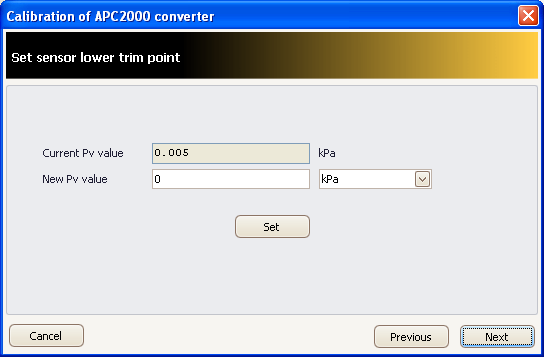
Calibration is performed on the input signal received from a sensor. Calibration eliminates errors, e.g. sensor and whole computing track aging errors. It is performed in selected points, in which it is required and possible to precisely define upper and lower standard signal (e.g. standard pressure). After input signal calibration, it is recommended to perform also analog output calibration.
Note: Values accepted for calibration points does not have to equal upper and lower limit of the basic range, but they cannot exceed them, and the width of calibration range cannot be lower than minimal adjusted range width. To obtain maximum accuracy, calibration points should coincide or be close to adjusted range start and end.
Note: Before input signal calibration (e.g. pressure, in case of pressure transmitters) it is recommended to perform zeroing of the transmitter first process variable.

It is necessary to adjust standard input signal, for which you want to perform lower point calibration, and then wait for stabilization of the signal read by the transmitter and indicated
in the field Current PV value.
New PV value should be filled up with a value equal to the standard input signal. The program allows to enter that value in any unit.
The above picture presents a situation, in which the standard input signal equals 0 kPa.
If values in both fields are stabilized, click the button Adjust.
If both values (current and new) differ widely, the transmitter may reject the values.This can indicate incorrect configuration, no zeroing, or improper transmitter operation.

It is necessary to adjust standard input signal, for which you want to perform upper point calibration, and then wait for stabilization of the signal read by the transmitter and indicated
in the field Current PV value.
New PV value should be filled up with a value equal to the standard input signal.
The above picture presents a situation, in which the standard input signal equals 7.5 kPa
If values in both fields are stabilized, click the button Adjust.
If both values (current and new) differ widely, the transmitter may reject the values. This can indicate incorrect configuration, or improper transmitter operation.

Note: Cancelling calibration is possible with the command Cancel sensor calibration.